Welcome to the vibrant bird-watching world of San Luis Obispo, home to a wide variety of native and migratory birds. With its diverse terrain and microclimates, San Luis Obispo offers a huge variety of habitats that attract a huge variety of birds from all over the world.
Whether you’re looking for the iconic California quail or the majestic bald eagle, San Luis Obispo has something for everyone. As a result, bird-watchers flock to San Luis Obispo year-round, eager to catch a glimpse of these magnificent creatures.
From the rolling hills of the coast to the rugged peaks of the inland valley, there are plenty of places to spot birds and enjoy the beauty of nature. So grab your binoculars and join us on a journey of discovery, as we explore the birds of San Luis Obispo.
1. Great Horned Owl
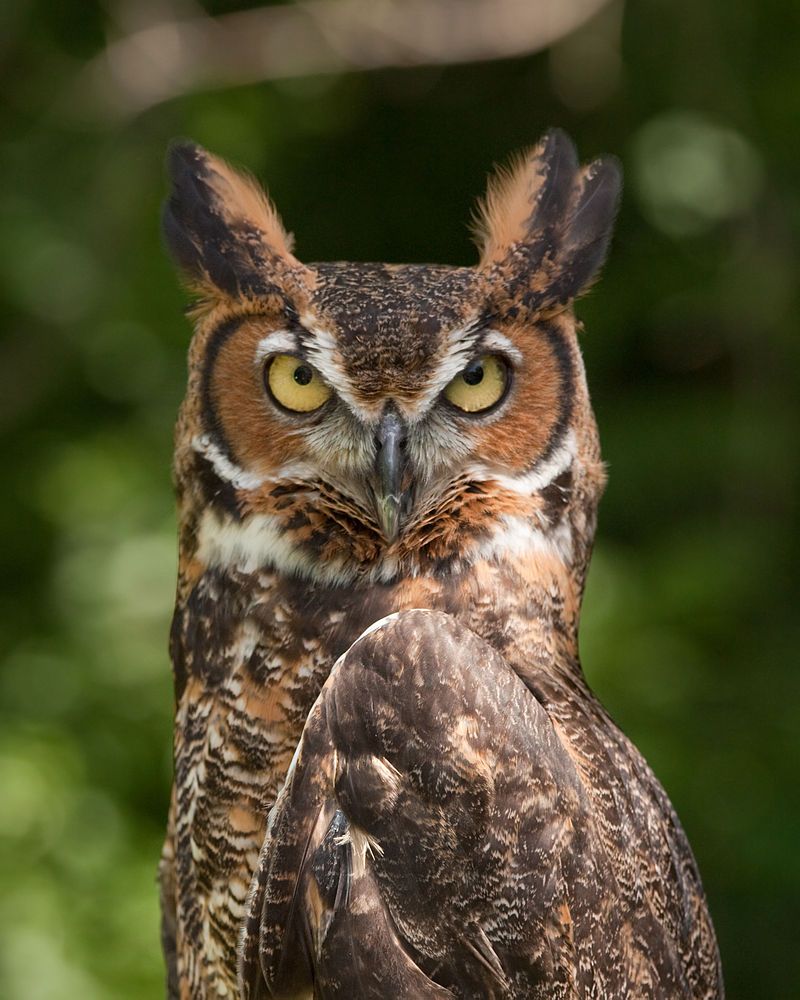
The great horned owl is a popular bird of prey found throughout the Americas. It is an apex predator that feeds mainly on small mammals, like rabbits and rodents and is the most widely distributed true owl in the region.
It is also known as the tiger owl or hoot owl due to the loud, hooting sound it makes. This owl is an extremely adaptable bird that can live in a wide variety of habitats including deserts, forests, wetlands, and grasslands.
It is also known for its large size, impressive wingspan, and distinctive tufts of feathers on its head. The great-horned owl has a highly developed sense of hearing, allowing it to locate prey in the dark.
Its eyes are also adapted to see in low-light conditions, making it a successful hunter.
Its broad wings and powerful talons help it to capture and kill its prey. Overall, the great horned owl is an impressive bird of prey that is well-adapted to a wide range of habitats across the Americas.
Its large size, impressive wingspan, and impressive hunting abilities make it a successful predator in its natural environment.
| Kingdom | Animalia |
| Phylum | Chordata |
| Class | Aves |
| Order | Strigiformes |
| Family | Strigidae |
| Genus | Bubo |
| Species | B. virginianus |
2. Burrowing Owl
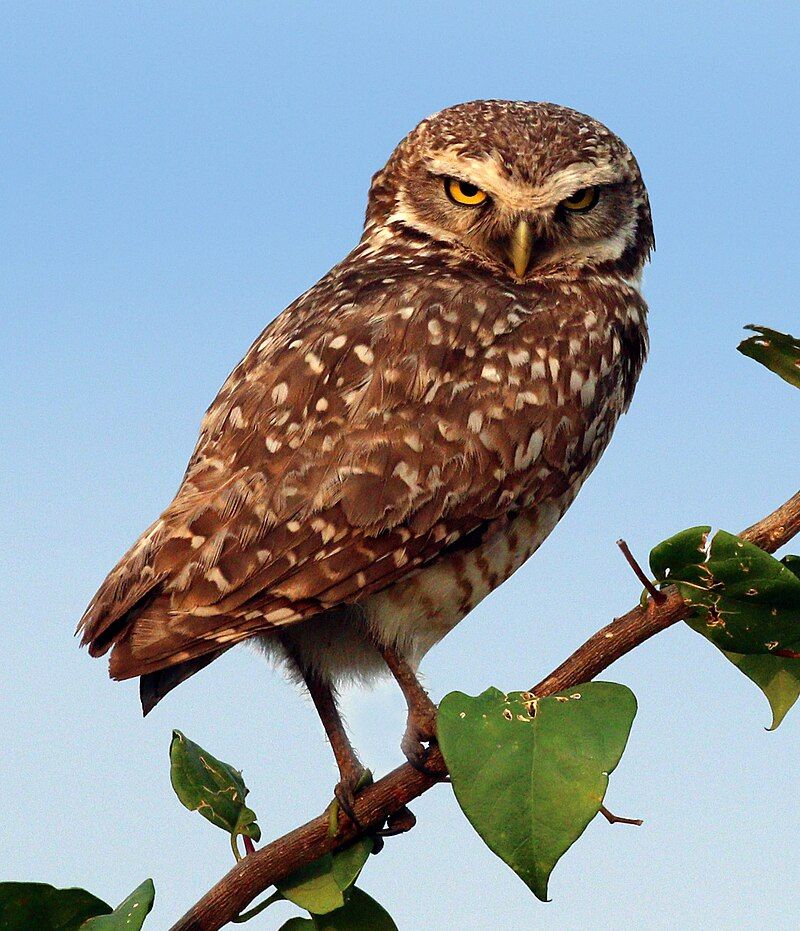
The burrowing owl, also known as the shock, is a small, long-legged species of owl found in many different parts of North and South America. It is often seen in open, dry areas with low vegetation, such as grasslands, rangelands, agricultural areas, and deserts.
Burrowing owls make their homes in the ground, as their name suggests. They will dig burrows, either in natural or abandoned animal dens, and line them with feathers and other soft materials to make them comfortable.
They may also use the burrows of other animals, such as tortoises, ground squirrels, and prairie dogs. These owls have adapted to different habitats by feeding on a variety of insects, small mammals, and reptiles.
They hunt during the day, and they use their camouflage to blend in with their surroundings while they wait for prey. Burrowing owls are also known to have a distinct call, which is a series of sharp, high-pitched whistles.
Burrowing owls are considered important species in their habitats as they help to maintain balance in the ecosystems by controlling insect and rodent populations. They also serve as an important food source for other predators, such as hawks, owls, and foxes.
Unfortunately, burrowing owls are becoming increasingly rare due to habitat destruction and loss, as well as the use of pesticides and other chemicals.
It is important to protect these owls and their habitats so that they can continue to play an important role in their ecosystems.
| Kingdom | Animalia |
| Phylum | Chordata |
| Class | Aves |
| Order | Strigiformes |
| Family | Strigidae |
| Genus | Athene |
| Species | A. cunicularia |
3. Barn Owl
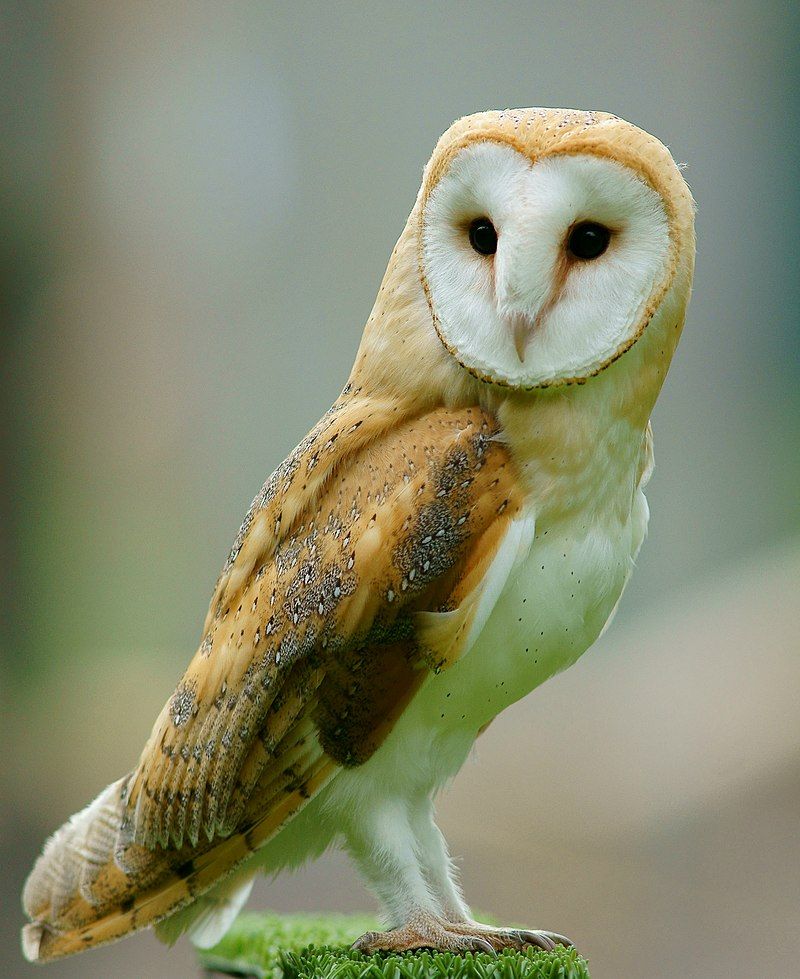
The barn owl is among the most widespread species of bird in the world, living in many different regions and environments.
It is found on every continent except Antarctica, and in numerous countries, excluding the polar and desert regions, Asia north of the Himalayas, most of Indonesia, and some Pacific Islands.
This species of owl is classified as one of the most common species of owl in the world and is found in various habitats, ranging from woodlands, grasslands, wetlands, agricultural areas, and even urban settings. The barn owl is a medium-sized owl, with a wingspan of up to four feet, and has a distinctive heart-shaped face that is often used to help identify the species.
It is usually a pale brown to rusty brown in color with darker brown spots and streaks.
The barn owl hunts primarily at night, using its exceptional hearing and vision to locate its prey, which consists of small mammals such as mice, shrews, voles, and even insects. The barn owl is a very adaptable species, able to survive in a variety of climates and habitats, and has a very successful reproductive rate.
This is due in part to its ability to nest in a variety of locations, such as tree cavities, barns, and even buildings. The barn owl is also a very vocal species, with a variety of hoots, shrieks, and other vocalizations that are used to communicate with one another.
Overall, the barn owl is an extremely successful species of owl and is an important part of the ecosystem in many parts of the world. It is highly adaptable and is found in many different habitats, and its presence is an indicator of a healthy and diverse environment.
| Kingdom | Animalia |
| Phylum | Chordata |
| Class | Aves |
| Order | Strigiformes |
| Family | Tytonidae |
| Genus | Tyto |
| Species | T. alba |
4. Turkey Vulture
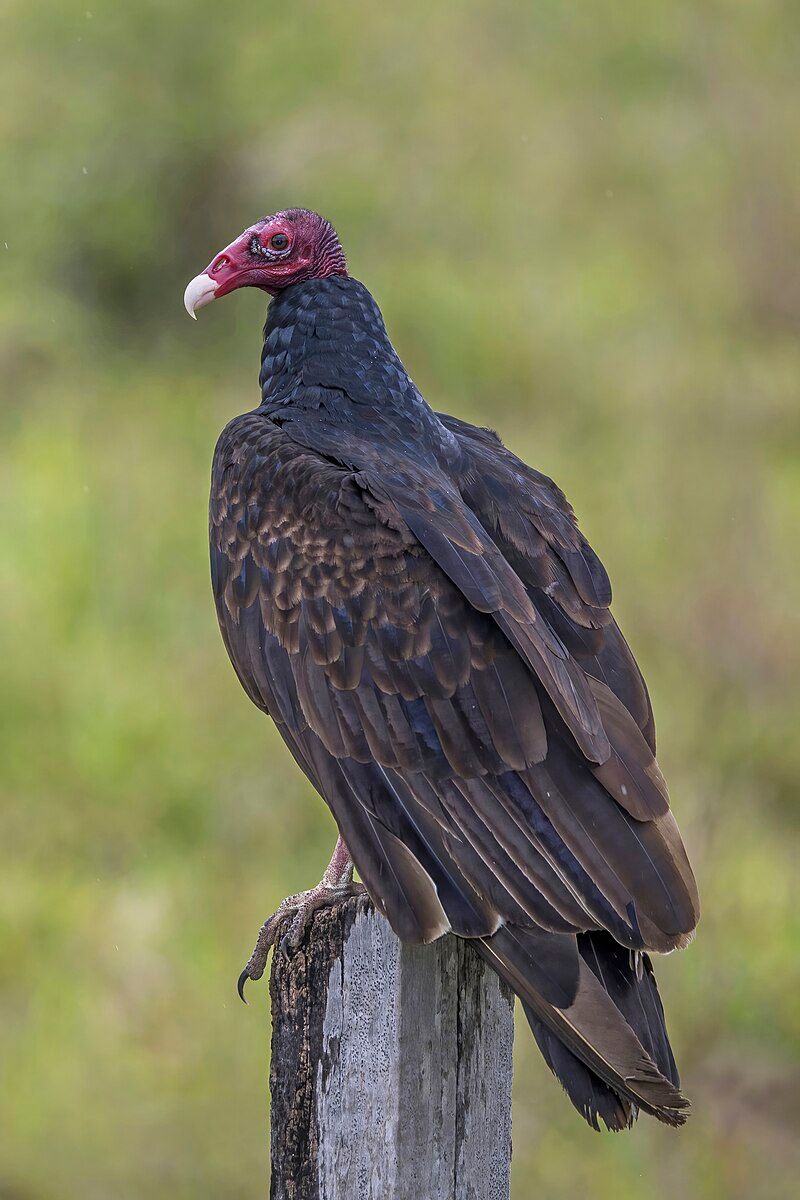
The turkey vulture is a species of vulture found across the New World or the Americas. It is one of three species in the genus Cathartes, which all belong to the family Cathartidae.
The turkey vulture is incredibly widespread and is found from southern Canada, all the way down to the southernmost tip of South America. This makes it the most wide-ranging of the New World vultures, and one of the most wide-ranging birds of prey in the Americas.
The turkey vulture is a large bird of prey, with an impressive wingspan of up to 1.5 meters. It has a distinctive red head and is dark brown with black feathers. It is a scavenger, and feeds mostly on carrion and other animal remains.
It is also known for its ability to use thermals to soar high in the air at great heights. The turkey vulture is an important species in the Americas. It is a key part of the ecosystem, helping to keep it clean by consuming dead animals.
It is also important to humans, as it can detect carcasses from long distances, and help alert humans to their presence.
| Kingdom | Animalia |
| Phylum | Chordata |
| Class | Aves |
| Order | Accipitriformes |
| Family | Cathartidae |
| Genus | Cathartes |
| Species | C. aura |
5. Red-Tailed Hawk
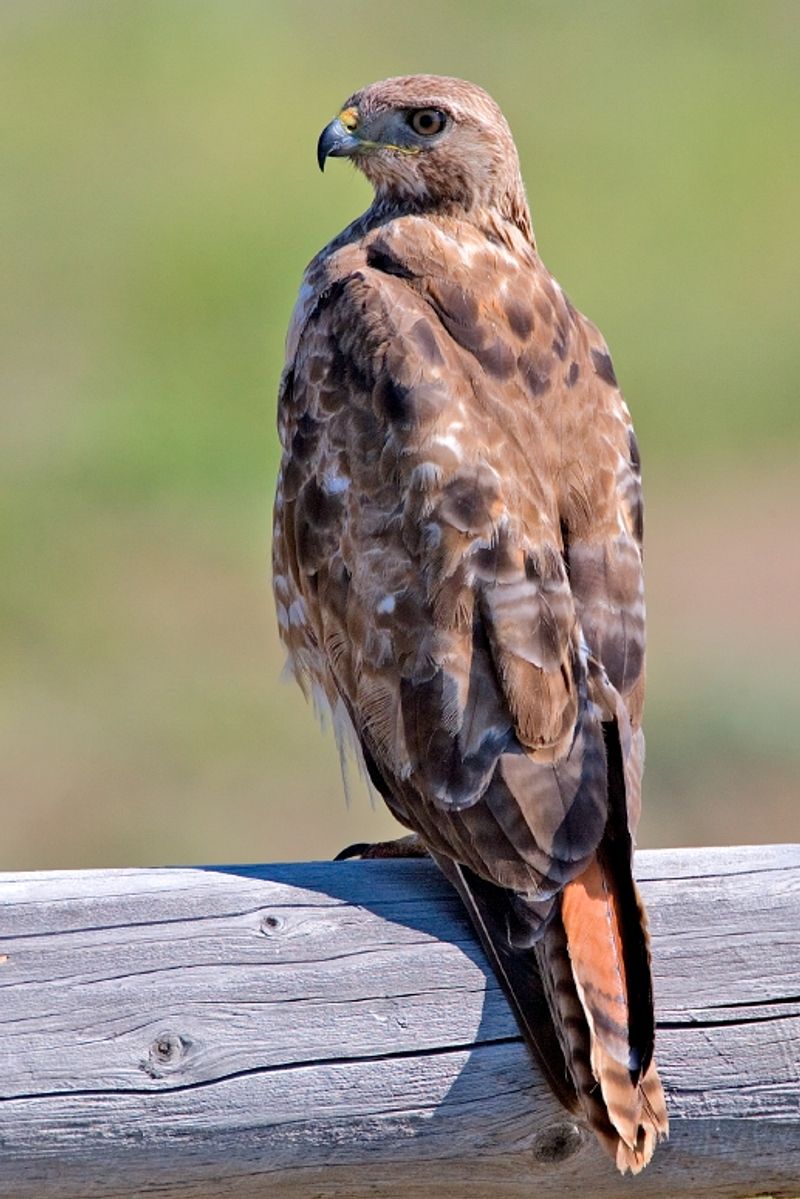
The red-tailed hawk is a predatory bird that can be found from Alaska and Canada in the north to Panama and the West Indies in the south.
It is a part of the Buteo genus, which is one of the most easily recognizable and widespread of all the raptor genera in North America and around the world.
Red-tailed hawks are large birds, with a wingspan of over four feet, and they can be seen soaring in the sky, searching for small mammals and birds to feed on. They have a distinctive red-brown tail, which is why they get their name.
Red-tailed hawks can be found in a variety of habitats, from grasslands to forests, and they can even be seen in urban areas. They can live up to fourteen years in the wild, and they are considered to be a symbol of strength and endurance.
| Kingdom | Animalia |
| Phylum | Chordata |
| Class | Aves |
| Order | Accipitriformes |
| Family | Accipitridae |
| Genus | Buteo |
| Species | B. jamaicensis |
6. Anna’s Hummingbird
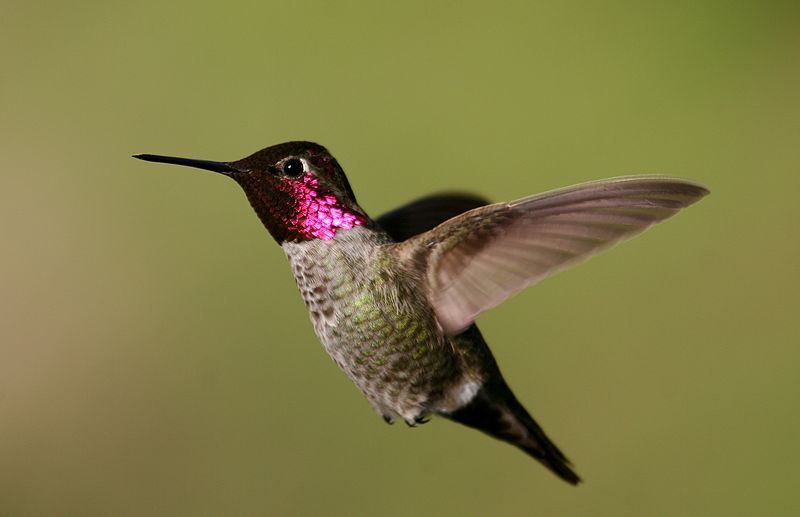
Anna’s hummingbird is a species of bird native to North America and is part of the family Trochilidae. It is a medium-sized bird, measuring about 3-5 inches in length.
The bird was named after Anna Masséna, Duchess of Rivoli, and is native to western coastal areas of the U.S. and Canada. In the early 20th century, Anna’s hummingbirds were known to breed only in northern Baja California and Southern California.
This species of hummingbird is often seen in gardens and parks near the coast, where they feed on nectar from flowers and insects. Anna’s hummingbirds are popular among birdwatchers due to their vibrant colors and unique behaviors.
They are also known to produce a variety of different sounds, including a high-pitched chirp, a squeaky twitter, and a low buzz. Overall, Anna’s hummingbird is an impressive species of bird that can be seen in many areas of the U.S. and Canada.
Its beautiful colors and unique behavior make it an interesting species to observe and appreciate.
| Kingdom | Animalia |
| Phylum | Chordata |
| Class | Aves |
| Clade | Strisores |
| Order | Apodiformes |
| Family | Trochilidae |
| Genus | Calypte |
| Species | C. anna |
7. White-Crowned Sparrow
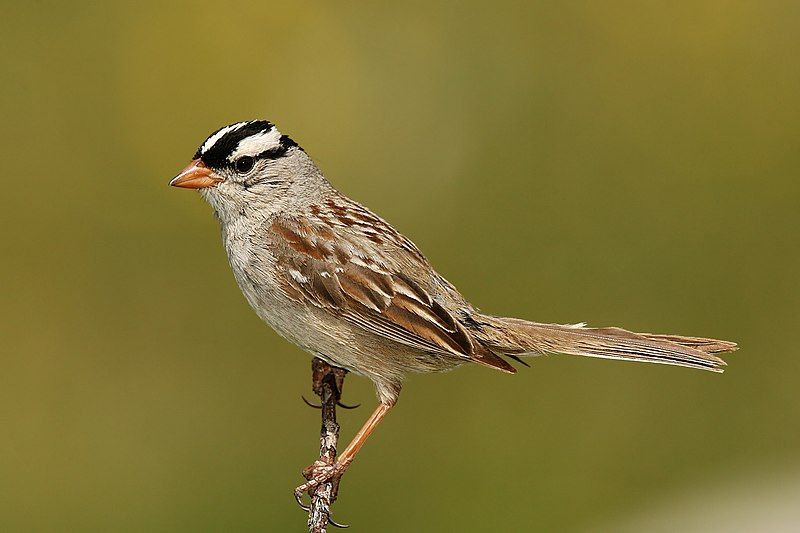
The white-crowned sparrow is a unique species of bird found in North America. It is a medium-sized passerine, belonging to the New World sparrow family. This species is immediately identifiable by its grey face and distinctive black and white streaking on the upper head.
The white-crowned sparrow is a common sight in forests, meadows, and other open habitats. It is a strong and agile flier, often seen in large flocks. The white-crowned sparrow is omnivorous, feeding on a variety of seeds, grains, insects, and berries.
During the breeding season, it builds a cup-shaped nest in a variety of different locations. It is known to be particularly vocal during this time, and its call is easily recognizable.
This species is also known to be highly territorial, and will aggressively defend its nest and territory from any intruders. The white-crowned sparrow is an important part of the North American avifauna.
It is a species of least concern and is not considered to be threatened or endangered. Although it is not a particularly popular bird among birdwatchers, its beauty and unique markings make it an important part of any North American nature preserve.
| Kingdom | Animalia |
| Phylum | Chordata |
| Class | Aves |
| Order | Passeriformes |
| Family | Passerellidae |
| Genus | Zonotrichia |
| Species | Z. leucophrys |
8. Yellow-Rumped Warbler
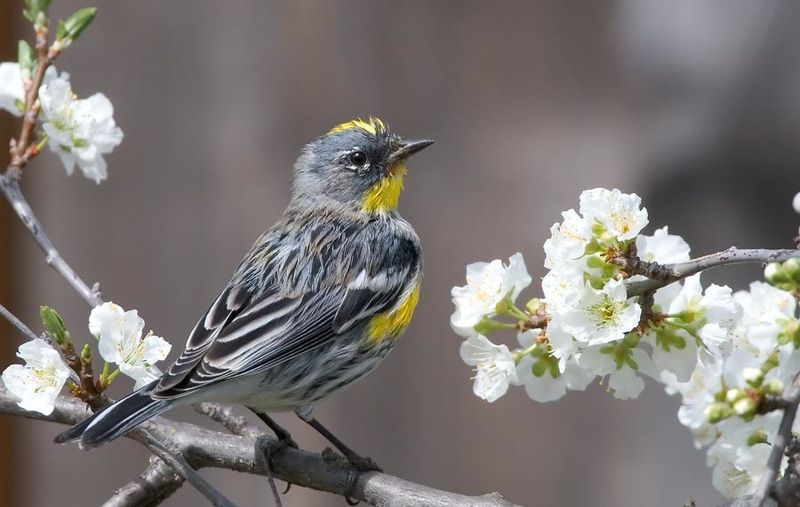
The yellow-rumped warbler is a species of bird that is native to North America. It is a common sight across the continent and can be observed in a variety of habitats, from woodlands to grasslands, and from coastal areas to mountain ranges.
This species prefers to stay close to the ground, often foraging for food among the leaf litter or in thickets. This bird is easily identified by its bright yellow rump and its distinctive song.
This species is a migratory bird and can be seen throughout the United States during the spring and summer months, while it will travel south to Mexico and Central America for the winter.
The yellow-rumped warbler has adapted to an urban lifestyle and can be found in parks and gardens in many cities. Its diet consists of insects, berries, and seeds, which it can find in abundance in these areas.
It is an important species of North American avifauna, and its presence is a sure sign of a healthy environment.
| Kingdom | Animalia |
| Phylum | Chordata |
| Class | Aves |
| Order | Passeriformes |
| Family | Parulidae |
| Genus | Setophaga |
| Species | S. coronata |
9. Western Bluebird
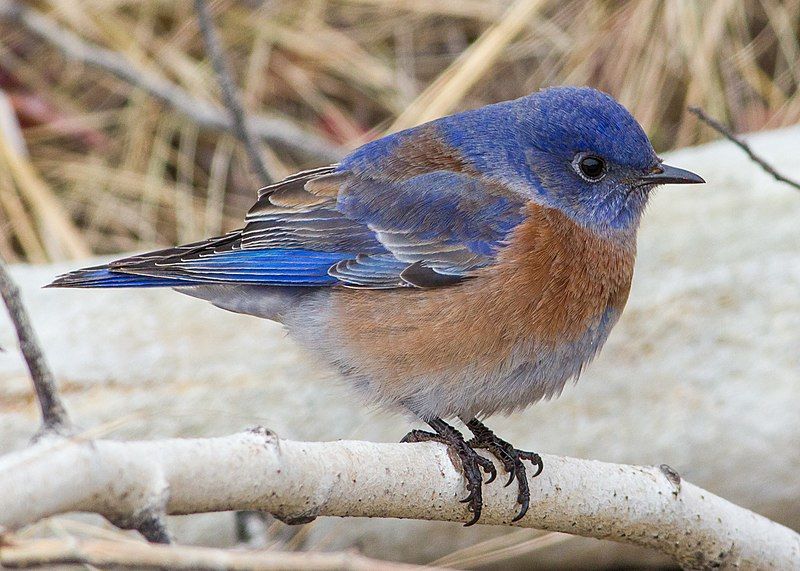
The western bluebird is a small bird that is native to North America and belongs to the thrush family. It is primarily found in the western parts of the continent, from Northern California and British Columbia in the north to Mexico in the south.
The western bluebird has a light grayish-blue back, wings, and tail, and a bright reddish-orange throat, breast, and belly. It has a white ring around its eyes and a black patch on its chin and throat.
Males are slightly more colorful than females, with brighter orange and blue plumage. Western bluebirds typically inhabit open woodlands, grasslands, orchards, and suburban areas.
They are social animals and often gather in flocks, though they are territorial and will defend their shared nesting area from other birds.
They mainly feed on insects, berries, and some fruits and seeds. Western bluebirds are a keystone species, meaning they have a significant impact on their local environment.
They help control insect populations by eating them, and their presence also helps to drive other species into the area. Western bluebirds also help to disperse seeds of many native plants, which helps to promote biodiversity.
As such, they provide important ecological services that benefit the environment.
| Kingdom | Animalia |
| Phylum | Chordata |
| Class | Aves |
| Order | Passeriformes |
| Family | Turdidae |
| Genus | Sialia |
| Species | S. mexicana |
10. Acorn Woodpecker
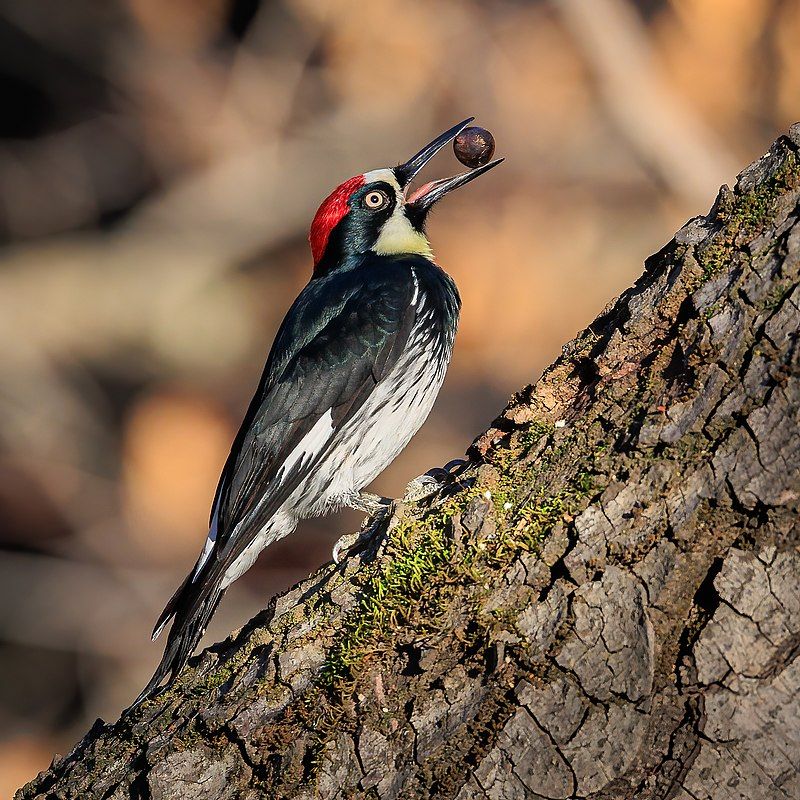
The acorn woodpecker is a unique species of bird that is found in western North America, from British Columbia to western Mexico. It is a medium-sized woodpecker, measuring 21 cm in length and weighing an average of 85 g.
Its namesake is derived from its love of acorns, which it stores in small holes in the bark of trees. The acorn woodpecker has a black body with white stripes, a red crest, and a white throat. The bird also has distinctive white markings on its wings and tail.
Its diet consists mainly of insects, but it also feeds on nuts, fruit, and sap. It will even eat other birds’ eggs and nestlings. The acorn woodpecker is an important species in many ecosystems, helping to keep insect populations in check and providing food for other animals.
Its presence is also important for the dispersal of acorns, which helps promote the growth of new trees.
| Kingdom | Animalia |
| Phylum | Chordata |
| Class | Aves |
| Order | Piciformes |
| Family | Picidae |
| Genus | Melanerpes |
| Species | M. formicivorus |
11. Long-Billed Curlew
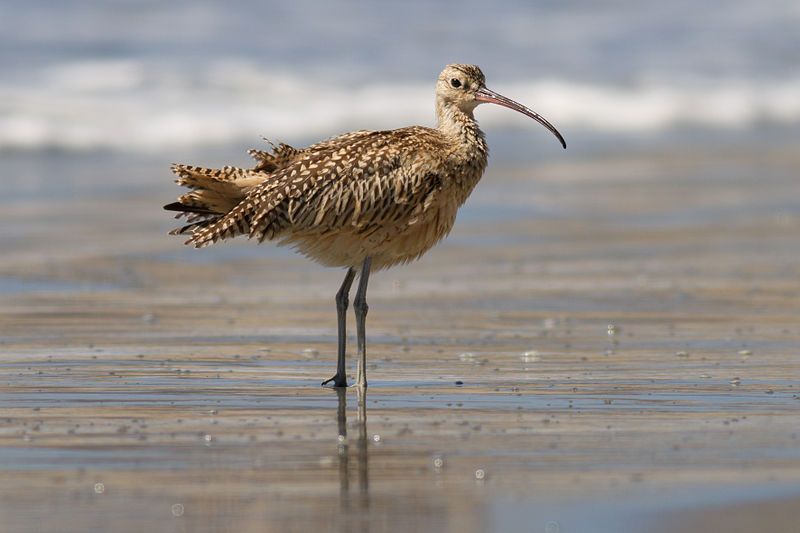
The long-billed curlew is a large, wading North American shorebird that belongs to the family Scolopacidae. It is sometimes referred to as the “sickle bird” or the “candlestick bird” due to its unique curved bill.
The long-billed curlew breeds mainly in the central and western parts of North America during the warmer months of the year. When the weather begins to cool, the species migrates southward and toward the coast to seek warmer climates.
This migration helps the long-billed curlew to survive the winter and provides them with a more comfortable habitat. The long-billed curlew is an essential species in many North American ecosystems and is an important part of the food chain.
Its presence is also important for maintaining the balance of nature in the area.
| Kingdom | Animalia |
| Phylum | Chordata |
| Class | Aves |
| Order | Charadriiformes |
| Family | Scolopacidae |
| Genus | Numenius |
| Species | N. americanus |
12. Osprey
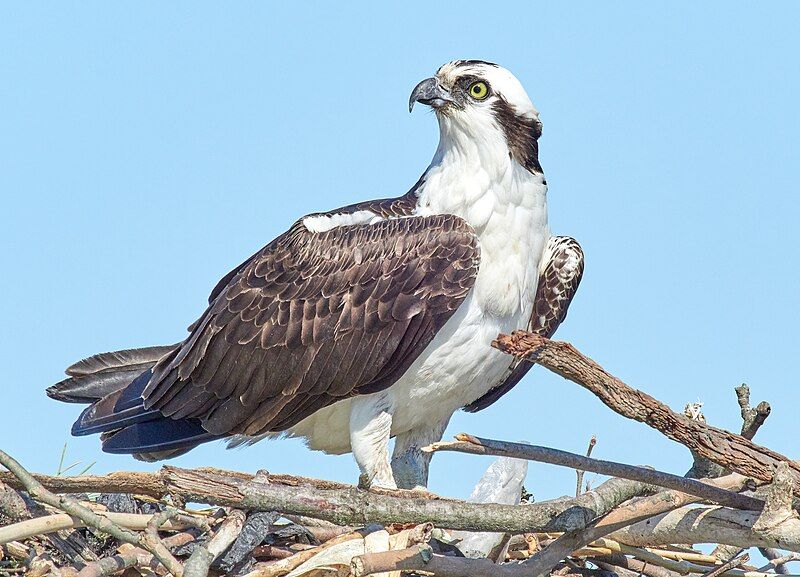
The osprey is a large bird of prey that can be found all over the world. It is commonly referred to as the sea hawk, river hawk, or fish hawk due to its diet which consists mainly of fish. It is a large raptor, measuring over 60 cm in length and with a wingspan of up to 180 cm.
This majestic bird is mostly brown on the upperparts with a greyish coloring on the head and underparts. It is most active during the day, or diurnal, and is an impressive sight to behold when soaring through the sky.
| Kingdom | Animalia |
| Phylum | Chordata |
| Class | Aves |
| Order | Accipitriformes |
| Family | Pandionidae |
| Genus | Pandion |
| Species | P. haliaetus |
13. House Finch
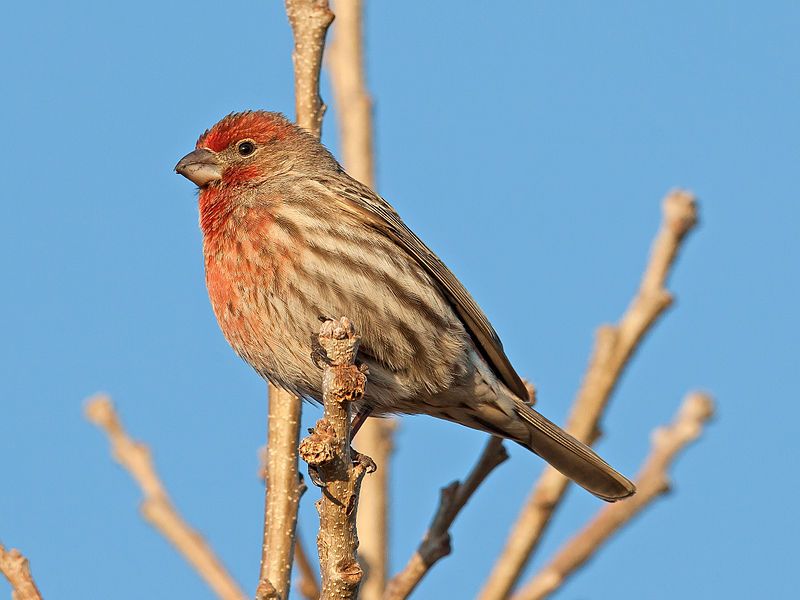
The house finch is a small bird that belongs to the Fringillidae family of finches. It is native to western North America and has been introduced to other parts of the continent, such as the eastern half and Hawaii.
The house finch is part of the genus Haemorhous, which also includes two other types of finches, known as the American rose finches. These birds are characterized by their bright coloring, which often includes shades of red and pink.
They are also known for their hardy nature, and they can be found in a variety of habitats, including forests, woodlands, and urban areas. House finches are social birds, and they can often be seen foraging and nesting in small groups.
They feed on a variety of items, including seeds, berries, and insects.
| Kingdom | Animalia |
| Phylum | Chordata |
| Class | Aves |
| Order | Passeriformes |
| Family | Fringillidae |
| Genus | Haemorhous |
| Species | H. mexicanus |
14. Long-Eared Owl
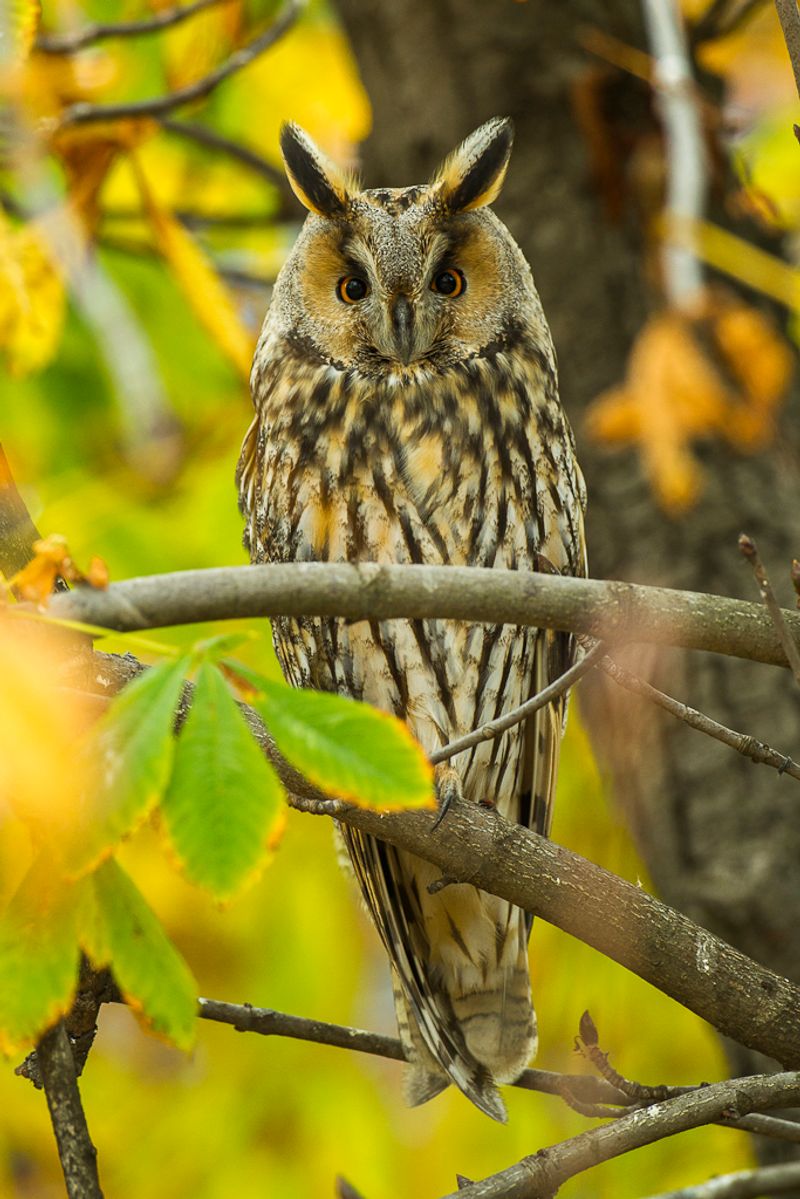
The Long-Eared Owl is a species of owl that is found across a wide range of habitats. Its scientific name, Asio otus, comes from Latin and refers to the type of eared owl that it belongs to.
It is sometimes referred to as the Northern Long-Eared Owl, the Lesser Horned Owl, or the Cat Owl. It is a medium-sized owl, with a wingspan of up to 40 inches. Its feathers are usually a pale grayish-brown in color, with white spotting and darker bars on the wings.
Its long, pointed ears are a distinctive feature, and they help it to locate prey in the dark. It has a wide variety of calls, including a rising whistle, a low hoot, and a loud, harsh ‘kee-yar’. Its diet consists of small mammals, insects, reptiles, amphibians, and birds.
The Long-Eared Owl is a solitary species, but it will form pairs during the breeding season. The female lays up to six eggs in a nest made of twigs and feathers, which are incubated by both parents for up to a month. The chicks are ready to leave the nest after about five weeks.
The Long-Eared Owl is a widespread species, found in Europe, Asia, North America, and parts of the Middle East. It is listed as a species of Least Concern on the IUCN Red List.
| Kingdom | Animalia |
| Phylum | Chordata |
| Class | Aves |
| Order | Strigiformes |
| Family | Strigidae |
| Genus | Asio |
| Species | A. otus |
15. Brewer’s Blackbird
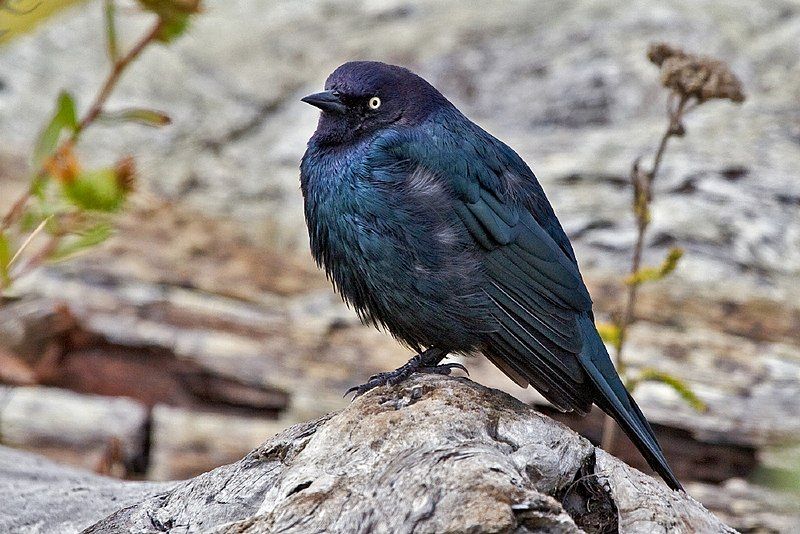
Brewer’s blackbird is a species of blackbird native to the Americas. It is a medium-sized songbird, with males measuring around 11.5 inches in length and females about 9.25 inches. Its plumage is predominantly black, with a glossy greenish-black head and neck, and yellow eyes.
The bird is named after the 19th century American ornithologist, Thomas Mayo Brewer. Brewer was a professor at Harvard University, where he conducted extensive research on the behavior and life cycles of birds.
He wrote many papers and books on the subject, including the influential book, The Birds of North America. He also served as the editor of the Bulletin of the Nuttall Ornithological Club, a publication devoted to the study of birds.
Brewer’s blackbird is a common sight in many parts of North America and can be found in a variety of habitats, ranging from forest and scrub to open fields and urban areas. It is a sociable bird and can often be seen in flocks.
The diet of Brewer’s blackbird consists mainly of insects and seeds, and the birds often feed on the ground or in low-lying shrubs and trees.
| Kingdom | Animalia |
| Phylum | Chordata |
| Class | Aves |
| Order | Passeriformes |
| Family | Icteridae |
| Genus | Euphagus |
| Species | E. cyanocephalus |
16. Nuttall’s Woodpecker
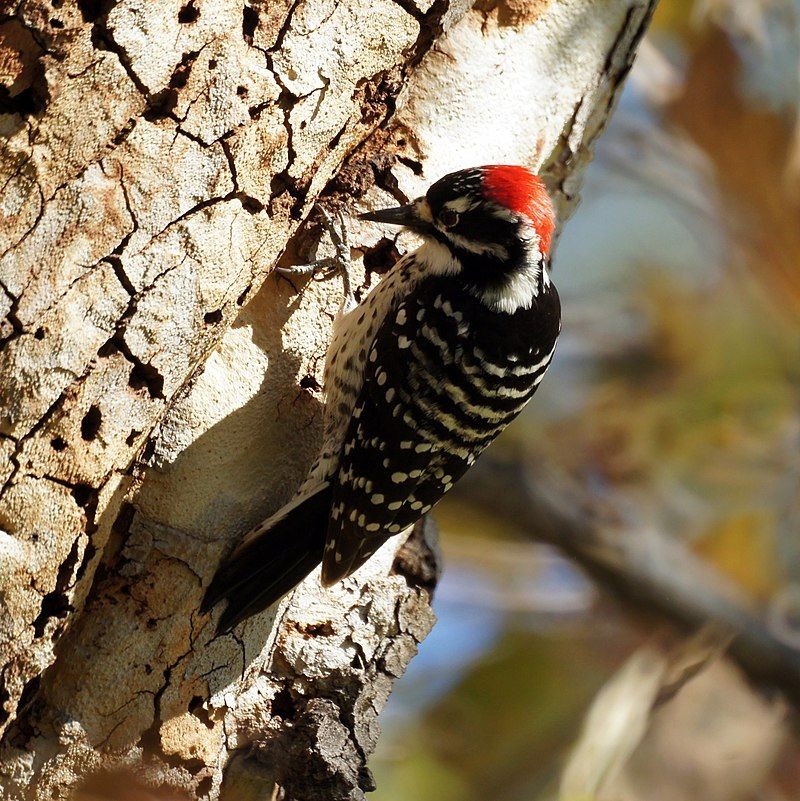
Nuttall’s woodpecker is a species of woodpecker that was given its name in 1843 by naturalist Thomas Nuttall. This species is native to oak woodlands in California and it is very similar to the ladder-backed woodpecker both in terms of its genetics and its appearance.
Nuttall’s woodpecker is mostly black in color, with its back having a series of white stripes along the length. It also has a white or yellow-tinged belly and a red patch on the back of its head.
The length of these birds is typically around seven to nine inches, and their wingspan can range anywhere from 12 to 15 inches. Genetically, Nuttall’s woodpecker and the ladder-backed woodpecker are closely related.
The two species are known to hybridize, meaning that they can interbreed and produce offspring. This hybridization is likely due to the two species living in the same areas and having similar features.
In addition, the two species have similar diets, which can contribute to hybridization. In terms of behavior, Nuttall’s woodpeckers are typically found searching for food on the trunks of trees.
They primarily feed on insects and larvae, which they can find under the bark of trees. In addition, they also feed on berries and nuts.
These birds are usually found in pairs or small groups, and they are known to travel in flocks during migration. Overall, Nuttall’s woodpecker is a unique species of woodpecker that is closely related to the ladder-backed woodpecker.
It is found in oak woodlands in California and it is easily recognizable by its black-and-white coloring and its red patch on the back of its head. These birds are typically found in pairs or small groups and they are known to feed on insects, larvae, and nuts.
| Kingdom | Animalia |
| Phylum | Chordata |
| Class | Aves |
| Order | Piciformes |
| Family | Picidae |
| Genus | Dryobates |
| Species | D. nuttallii |
17. Red-Winged Blackbird
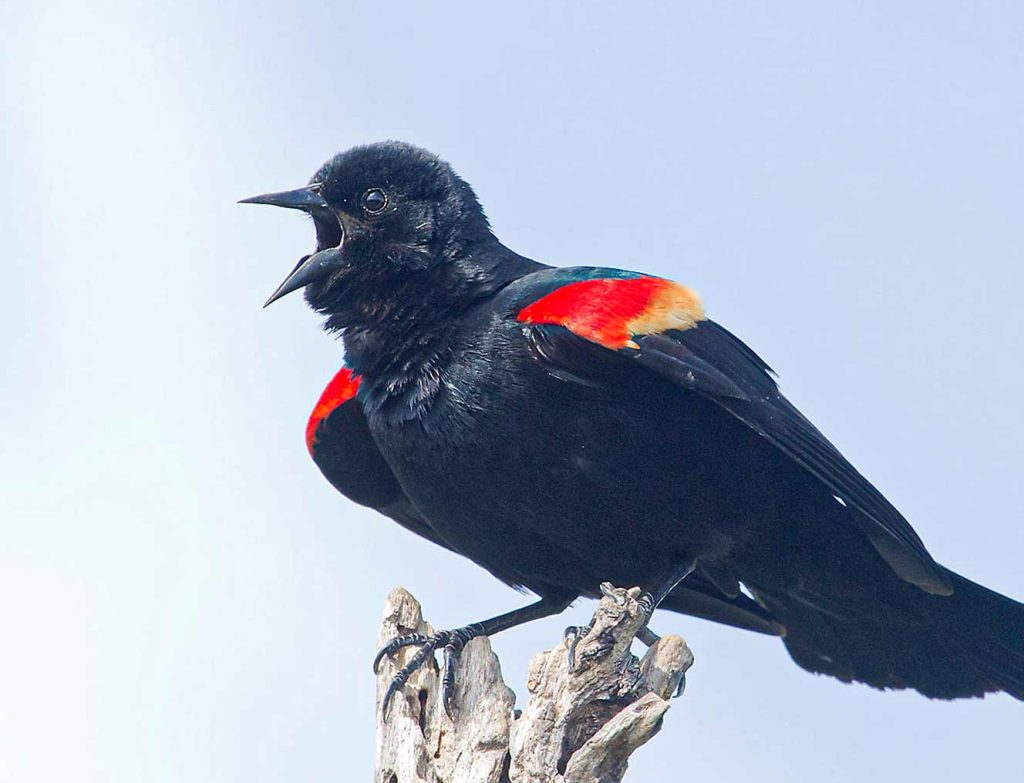
Source: vtecostudies.org
The red-winged blackbird is an iconic bird species found across much of North America and Central America. It is a passerine bird, which means it belongs to the order Passeriformes, and it is from the family Icteridae.
This bird is easily recognizable due to its unique plumage; its body is black with a bright red patch on its shoulder and a yellow band across its wing.
It is a fairly large bird, measuring up to eight inches in length, and its wingspan is usually between 14-17 inches. The red-winged blackbird is primarily found in wetlands, such as marshes, swamps, and lakeshores.
It can also be seen in open fields, grasslands, and agricultural areas. During the warmer months of the year, it can also be seen in suburban areas. The red-winged blackbird is an omnivorous species, meaning it eats both plants and animals.
Its diet consists mainly of insects, but it also feeds on seeds, berries, and other plant matter. The red-winged blackbird is known for its distinctive song, which is a series of loud and repetitive chirps.
This song is used by the male to attract a mate and to mark its territory.
The red-winged blackbird is also known to be a very social species, often forming large flocks of up to several hundred birds. Overall, the red-winged blackbird is an iconic bird species found across much of North America and Central America.
It’s unique appearance and distinctive song make it a popular bird among birdwatchers, and its social behavior makes it a pleasure to observe in the wild.
| Kingdom | Animalia |
| Phylum | Chordata |
| Class | Aves |
| Order | Passeriformes |
| Family | Icteridae |
| Genus | Agelaius |
| Species | A. phoeniceus |
18. Bushtit
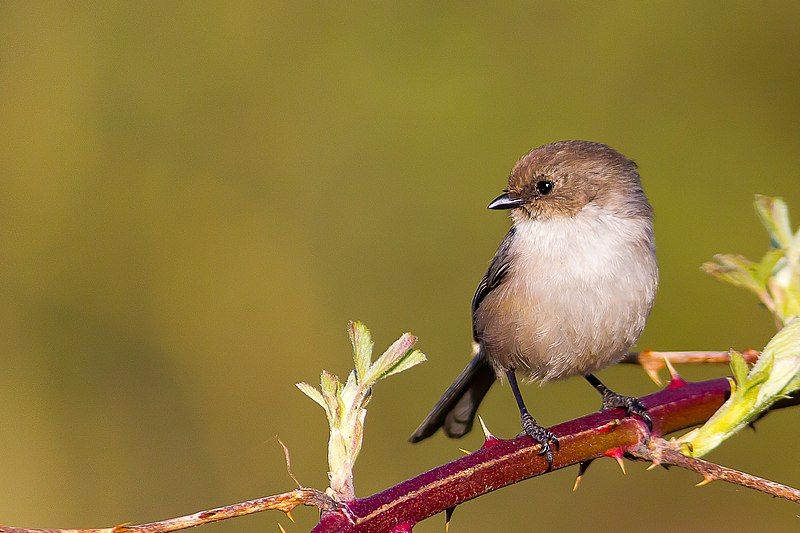
The American bushtit is a small bird that belongs to a unique genus and family. It is the only species of bird in the genus Psaltriparus and the only species in the family Aegithalidae that is found in the New World.
This species of bird is native to the western regions of North America, ranging from Alaska and Canada to Mexico. The American bushtit is a small, drab-colored bird with a long, slender bill. It is a very social bird, often seen in flocks of up to 30 individuals.
Its diet consists of small insects, spiders, caterpillars, and other invertebrates. The American bushtit is an important species to the ecology of its native habitats, as it helps keep insect populations in check.
It is also an important food source for larger birds and mammals, such as hawks and owls.
| Kingdom | Animalia |
| Phylum | Chordata |
| Class | Aves |
| Order | Passeriformes |
| Family | Aegithalidae |
| Genus | Psaltriparus |
| Species | P. minimus |
19. American Kestrel

The American kestrel, also known as the sparrow hawk, is a small falcon that is common in North America. It has a broad range of sizes, depending on the subspecies and sex.
The kestrels range in size from the weight of a blue jay to that of a mourning dove, with males usually being larger than females. This range in size makes the American kestrel one of the most diverse species of falcon in North America.
The American kestrel is easily recognizable due to its unique coloration. It has a mottled brown back and wings, with a barred tail and a white breast. Its head is usually a rufous color with black streaks, and it has yellow feet and a yellow beak.
The American kestrel is also well known for its hunting style, which involves hovering in the air and then plunging to the ground to catch its prey. The American kestrel is an important part of the North American environment, both as a predator and as a prey species.
It feeds on a variety of small mammals, reptiles, and insects. In turn, it is preyed upon by larger birds of prey, such as hawks and owls. The American kestrel is also important to humans, as it helps to keep insect and rodent populations in check.
For these reasons, the American kestrel is an important species in North America.
| Kingdom | Animalia |
| Phylum | Chordata |
| Class | Aves |
| Order | Falconiformes |
| Family | Falconidae |
| Genus | Falco |
| Species | F. sparverius |
20. Wood Duck
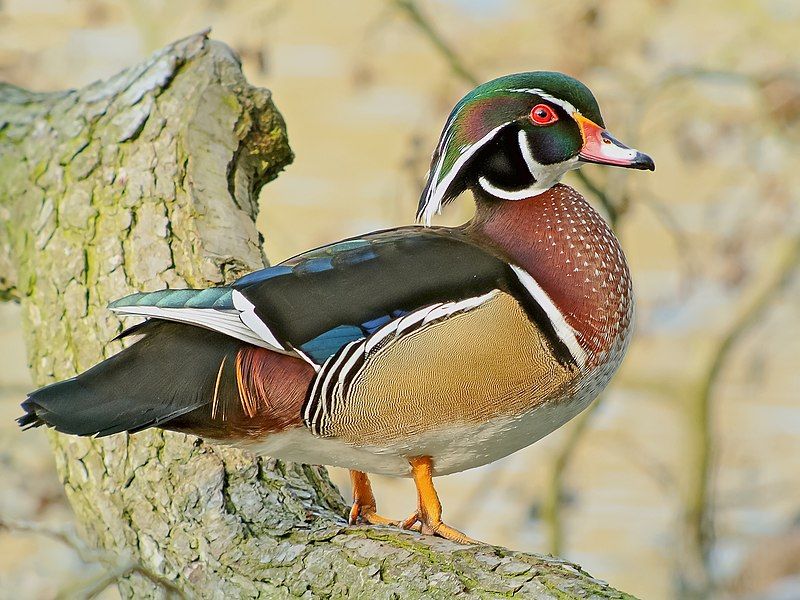
The wood duck or Carolina duck is a beautiful bird that can be found in North America. It is a species of perching duck, which means it has strong claws that allow it to perch in trees.
The drake wood duck is the male of the species, and it is particularly striking in appearance. With its distinctive plumage, it is one of the most colorful North American waterfowl.
The head and neck of the drake wood duck are glossy green, while its chest and sides are a chestnut-brown color. The wings have bright white and black markings, while its tail is a contrasting white.
The Drake wood duck also has a vibrant red bill, and its eyes are a striking yellow. Altogether, these colors make the wood duck a vibrant and beautiful addition to any landscape.
| Kingdom | Animalia |
| Phylum | Chordata |
| Class | Aves |
| Order | Anseriformes |
| Family | Anatidae |
| Genus | Aix |
| Species | A. sponsa |
21. Western Screech Owl
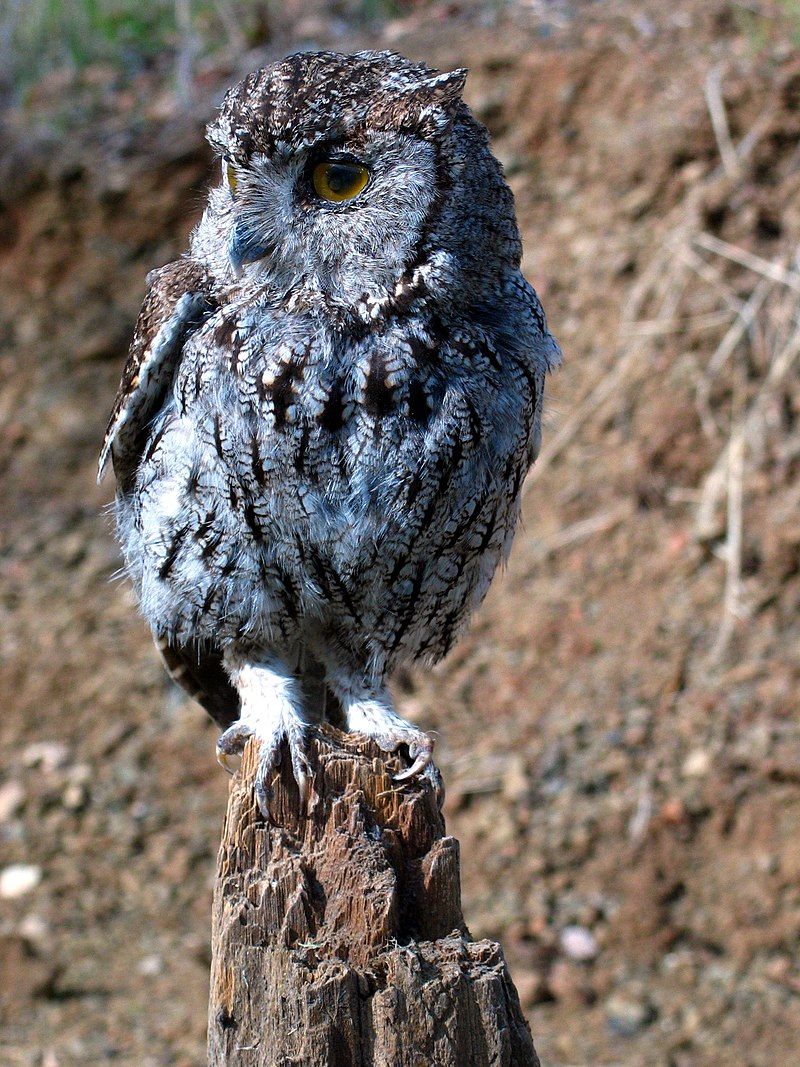
The western screech owl is a small owl native to North and Central America, making it a widespread species in the Americas. It is closely related to the eastern screech owl, another species of small owl found in North America.
The western screech owl’s scientific name, Megascops kennicottii, is a tribute to the American naturalist Robert Kennicott, who lived in the mid-1800s and conducted extensive research on the wildlife of the American Northwest.
Kennicott is credited with discovering several species of birds, including the western screech owl. He also collected and cataloged numerous specimens of plants, birds, and mammals, and his work has been instrumental in advancing the field of natural history.
The naming of the western screech owl in his honor is a testament to the lasting legacy of the research conducted by Robert Kennicott.
| Kingdom | Animalia |
| Phylum | Chordata |
| Class | Aves |
| Order | Strigiformes |
| Family | Strigidae |
| Genus | Megascops |
| Species | M. kennicottii |
22. California Thrasher
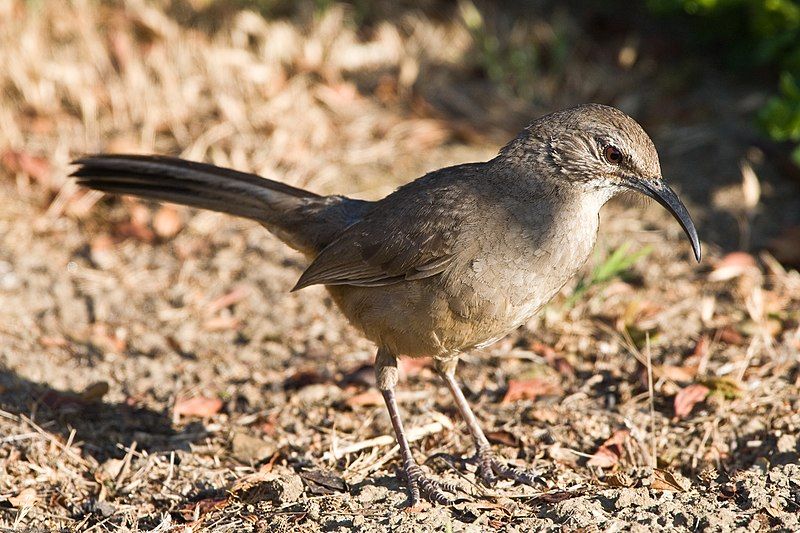
The California thrasher is a species of bird belonging to the family Mimidae. It is found in the chaparral habitats of California and Baja California and is the only member of its genus, Toxostoma, in the region.
The California thrasher is a large bird, with a long, curved bill, and a gray-brown body with white streaks. It has a distinct, melodious song, which plays an important role in its courtship and territorial displays.
This song is often repeated and can be heard up to half a mile away. It is an omnivore, feeding on fruits, seeds, insects, and small vertebrates. It can also be found in wooded areas and gardens, and can sometimes be seen hopping on the ground in search of food.
The California thrasher is a solitary species and usually maintains its territory by defending it against other birds.
| Kingdom | Animalia |
| Phylum | Chordata |
| Class | Aves |
| Order | Passeriformes |
| Family | Mimidae |
| Genus | Toxostoma |
| Species | T. Redivivum |
23. Loggerhead Shrike
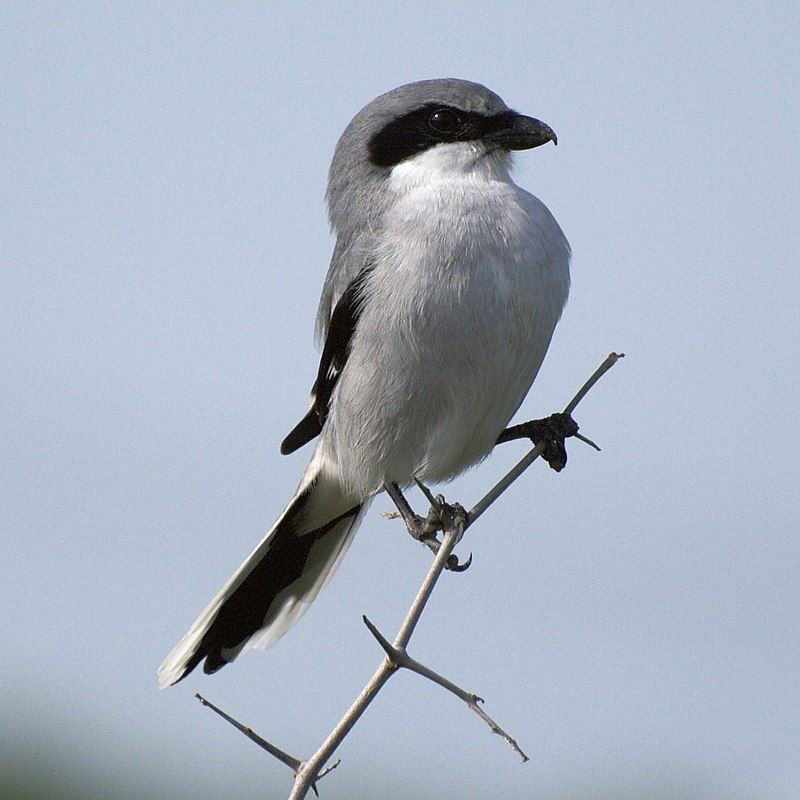
The loggerhead shrike is a unique bird belonging to the family of birds known as Laniidae. It is the only species of shrike that is native to North America, while the related northern shrike is found in other regions, such as Siberia.
The loggerhead shrike is distinguished by its black mask-like facial markings, gray upperparts, and white underparts. Its diet consists mainly of insects, lizards, and small mammals, which it captures with its sharp talons and beak.
It often impales its prey on a thorn or barbed wire, making it easier to consume. The loggerhead shrike is found throughout North America, ranging from southern Canada to Mexico. The species prefers open habitats such as grasslands, shrublands, and woodlands.
They perch on exposed branches and posts, from which they can spot potential prey. During the breeding season, it is known to be highly territorial and will aggressively defend its nesting area.
The loggerhead shrike is listed as a vulnerable species due to its declining population. Its population has been reduced by over half since the 1970s, due to a variety of factors including habitat destruction, pesticides, and predation by larger birds.
Conservation efforts, such as habitat protection and reintroduction programs are currently underway in an attempt to save the species.
| Kingdom | Animalia |
| Phylum | Chordata |
| Class | Aves |
| Order | Passeriformes |
| Family | Laniidae |
| Genus | Lanius |
| Species | L. ludovicianus |
24. Allen’s Hummingbird
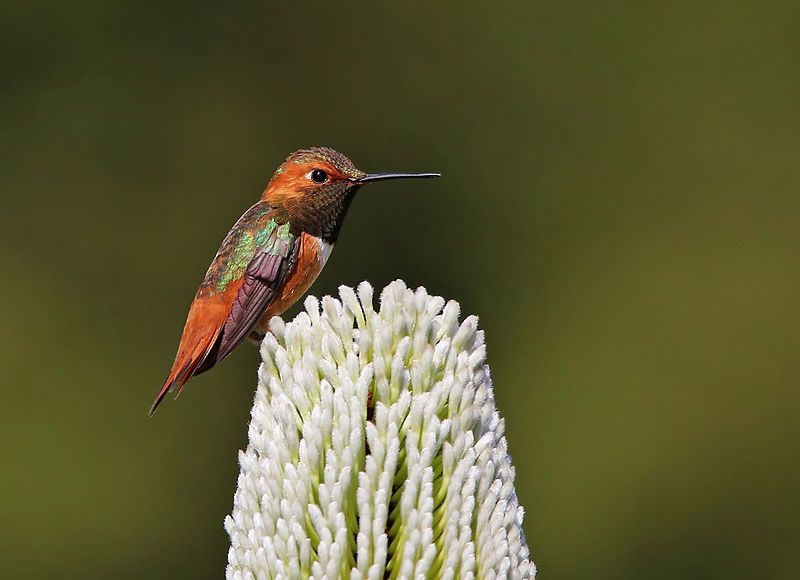
Allen’s hummingbird is a species of hummingbird that is native to the western United States. It is a small bird, usually ranging in size from 3.1 to 3.3 inches long. It has a metallic green back and head, with a white underbelly and a white patch on the throat.
The wings and tail are reddish-brown. The male has a reddish-orange patch on the throat, while the female has a throat patch that is white. Allen’s hummingbird is one of seven species in the genus Selasphorus. These hummingbirds are found in open woodlands, meadows, and gardens.
They feed on nectar from flowers and insects, and they can often be seen hovering in mid-air as they feed. They are also attracted to feeders stocked with a sugar-water solution.
The Allen hummingbird is an important pollinator of many plants in its native habitat and is an important part of the local ecology. It is also an important cultural symbol of the Western United States, as it is often seen in art and literature.
| Kingdom | Animalia |
| Phylum | Chordata |
| Class | Aves |
| Clade | Strisores |
| Order | Apodiformes |
| Family | Trochilidae |
| Genus | Selasphorus |
| Species | S. sasin |
Conclusion
San Luis Obispo is home to a variety of bird species. From the charismatic Western Scrub Jay to the majestic Red-tailed Hawk, there is something to be enjoyed by birders of all levels.
With the abundance of protected lands, open space, and coastal estuaries, San Luis Obispo is an ideal destination for birders looking to explore the region’s diverse avian populations.